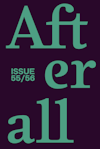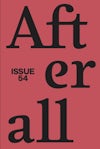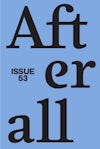
Issue 27
Summer 2011
Featuring artists Andrea Zittel, Jef Geys, Dexter Sinister and Minerva Cuevas; contextual essays on French feminist video collectives of the 1970s, the legacy of Marxist education in East Germany and a revisitation of Mapping the Terrain: New Genre Public Art.
Editors: Pablo Lafuente, Nuria Enguita Mayo, Dieter Roelstraete, Melissa Gronlund, Stephanie Smith.
Founding editors: Charles Esche, Mark Lewis.
Table of contents
Foreword
Contextual Essays
- Disobedient Video in France in the 1970s: Video Production by Women’s Collectives – Stéphanie Jeanjean
- Letter to the Editor: Disobedient Video
Artists
Dexter Sinister
- Propositions and Publications: On Dexter Sinister – Saul Anton
- A Flibbertigibbet, a Will-o’-the-wisp, a Clown (Or 10 Reasons Why Graphic Design Is Not the Issue) – Anthony Elms
Minerva Cuevas
- Minerva Cuevas: Anarchy in the Hive – Francis McKee
- Minerva Cuevas and the Art of Para-sitic Intervention – Jean Fisher
Andrea Zittel
- ABC West: On Playgrounds and Andrea Zittel – Lisa Anne Auerbach & Robby Herbst
- A–Z West in Context: A Spatial Analysis – Steve Rowell
Jef Geys
- Jef Geys’s Art-Making Ethics – Chris Sharp
Jef Geys
- The Really Ignorant Schoolmaster: Jef Geys, Amongst Many Others – Dieter Roelstraete
Events, Works, Exhibitions
- Sympathy Is a Bridge for Ideology: Phil Collins’s Adventures in Marxism? – Michèle Faguet Mapping the Terrain, Again
Foreword
Written by Melissa Gronlund
What do we mean when we say ‘mapping a territory’? It is a common way to speak about exhibitions, particularly to underline that a study of a given field is going to be objective in aim and somehow scientific in method: not a best-of, but a faithful representation of the different trends and formats coexisting and perhaps intersecting in a locally defined area of art practice. ‘Von hier aus’, for example, curated by Kasper König in 1984, looked at the work produced in Germany in the 1980s, while Paul Schimmel’s ‘Helter Skelter’ (1992) examined art in Los Angeles in the 1990s, and ‘Nought to Sixty’ (2008), curated by Mark Sladen and Richard Birkett, looked at work made by sixty artists in the British Isles in the late 2000s. For the organisation of these exhibitions, mapping provides a framework by which disparate trends can become linked, the show emerging as a plan — or to borrow a phrase from Dexter Sinister, a collective featured in this issue, it puts the work ‘in plan view’ — in which tendencies can be seen more clearly. The methodology and its implications of objectivity aren’t exclusive to the art world. Utilising mapping over the past thirty years has allowed historians to access a wider swathe of the past, looking at the social life of ‘ordinary’ men and women — rather than the lives of those in the political or cultural elites, whose activities and opinions had been the focus until then. 1 By analysing where a populace lived, and where essentials like schools and grocery stores, bookstores, luxury purveyors or cultural venues were located, historians can gain a sense of the life of a time that might not have been recorded or otherwise passed down.
This issue of Afterall addresses these questions through the work of artists with different relations to the act of mapping, the land and locality. Andrea Zittel’s interest in California’s Joshua Tree National Park and its surroundings, which she has used as the staging ground for her collaborative projects, sustains a focus not just on the land, but on the interaction between the park and its inhabitants: do humans react differently within different vistas? Jef Geys’s highly localised practice, centred in his hometown of Balen, Belgium, suggests a similar escape from the institution of art: if implicit in participatory art’s anti-elitism and its use of ‘everyone’ rather than ‘the anointed few’ is a form of institutional critique, then Geys’s attempts to open up artistic practice by delineating it through spatial territory (rather than through social code or norm) is indeed a reformation of the whole art system. The idea of mapping as revelatory — implicit also in the exhibitions cited above — is germane to Suzanne Lacy’s Mapping the Terrain: New Genre Public Art (1995), a seminal survey of public and participatory artwork (re-assessed here by Stephanie Smith), which sought to create the field as much as document it.
In putting together this issue, we also thought of other ways to look at ‘mapping’, and specifically wondered if one can ‘map’ dissemination in any meaningful sense. Taken literally, the parallels between the two concepts seem to suggest so: mapping provides a cartographic history of the tributaries that information — printed, videotaped or spoken — might take. But also implicit in the word ‘dissemination’ is the sense of chains-of-command being overwhelmed — to disseminate something, ideally, is to pass it beyond a chain of personal acquaintances or to move it beyond what can be adequately charted.
Purchase
The publication is available for purchase. If you would like specific articles only, it is also available individually and to be downloaded as PDFs.
Purchase full publication
Buy via University of Chicago Press
Buy via Central Books
Purchase individual articles
Buy via University of Chicago Press



